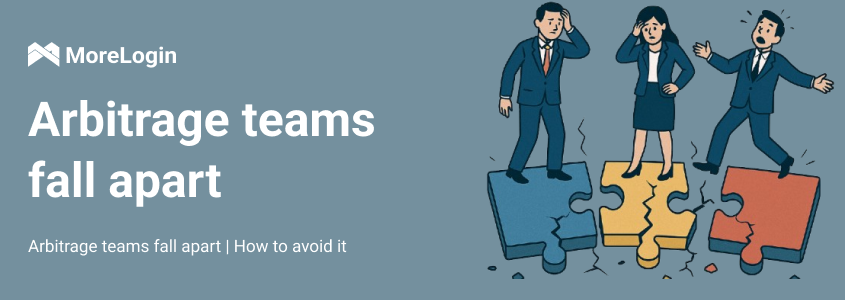
- Product

- Pricing
- Affiliate Program
- Use Cases
- Resource


Working in a team means faster growth, shared experience, and scalability. This is especially true in affiliate arbitrage, where teamwork allows you to launch multiple funnels, test new traffic sources, and delegate responsibilities. But in practice, even the strongest teams can fall apart over time.
So, why does this happen—and can it be avoided? Let’s dive in.
A team without defined roles is like a bicycle without handlebars. No one knows who's responsible for what, tasks overlap or get lost entirely, and results suffer.

What’s the solution?
From day one, establish a clear team structure and define everyone’s responsibilities. This is critical for stable and effective operations—especially in traffic arbitrage, where speed and coordination directly impact performance.
Even if your team is small (2–3 people), roles must be defined to avoid confusion, duplicated tasks, and eventual chaos.
Here’s the foundational structure every arbitrage team should implement:
Responsible for overall strategy, task delegation, deadlines, and quality control. The team lead is the glue holding everyone together, making key decisions and ensuring consistent workflow.
Creates ad assets like banners, videos, copy, and concepts. Their work determines how appealing the campaigns are to the target audience. They also test hypotheses around formats, styles, and ad approaches.
Handles ad accounts, sets up and scales campaigns, manages bids, budgets, and performance metrics. Ideally, the buyer should work closely with the creative specialist and analyst for real-time optimization.
Manages affiliate networks and offer selection. Negotiates payouts, gets white/blacklists, monitors offer performance, and ensures access to landing pages and pre-landers.
Gathers data, builds reports, tracks KPIs (CR, ROI, EPC, CTR, etc.), and helps the team make decisions based on data—not guesswork. Analysts are crucial for identifying winning combinations and eliminating what doesn’t work.
Important note:
Even in a small team, these functions must be covered. One person can wear multiple hats, but responsibilities need to be clearly outlined. Without structure, even the most talented team will crumble under pressure.
Money disputes are a classic team-killer—especially when there’s no transparency on who contributes what and who earns how much. One person might carry the team, while another just “gets a cut” without real input.

Establishing fair compensation from the start is key to team harmony and motivation. Everyone should understand their expected contributions and how their earnings are calculated.
Here are a few popular profit-sharing models:
Motivates everyone to focus on results. You can use a fixed or role-based share (e.g., 10% for the team lead, 15% for the media buyer, 7% for the creative). Just be transparent about how profit is calculated and which expenses are deducted first.
Combines stability with performance incentives. Example: a fixed base for creatives or analysts, plus bonuses for hitting KPIs (e.g., ROI increase, CTR growth). Bonuses can be short-term (monthly) or long-term (quarterly/yearly).
Tied to measurable results. For example, buyers must hit ad spend targets; analysts must deliver accurate, timely reports; creatives must test and deliver winning assets. This ensures objective performance evaluation and fair rewards.
Everyone should understand what they’re being paid for—and what success looks like.
Only running traffic from Facebook? Focused on nutra in Thailand? Working with one advertiser? You’re playing a risky game.
Even minor changes—platform bans, offer burnout, or algorithm updates—can end your cash flow instantly.
Use at least 2–3 traffic sources to avoid dependency. For example, combine Facebook Ads, Google Ads, TikTok, Native Ads, or search campaigns. Each has unique pros and cons—some offer lower CPC, others higher conversion rates.
If a platform blocks your account or changes its rules, a diversified setup lets you switch quickly without losing momentum.
Multiple verticals = more flexibility.
If your team only works in one niche (e.g., fintech or health & beauty), market changes can tank your performance. Expanding into verticals like eCommerce, education, credit, or cosmetics gives you maneuverability in a shifting landscape.
Platforms like MoreLogin allow your team to manage multiple ad accounts on one platform safely and seamlessly. This reduces downtime and ensures uninterrupted campaign performance, even if one account is compromised.
In arbitrage, a team is your most powerful resource. But if you only focus on ROI and ignore structure, transparency, and team safety, it won’t last long.
Set up clear processes, define roles, and equip your team with the right tools. If you do, you’ll create a high-performing, sustainable team that grows and profits long-term.